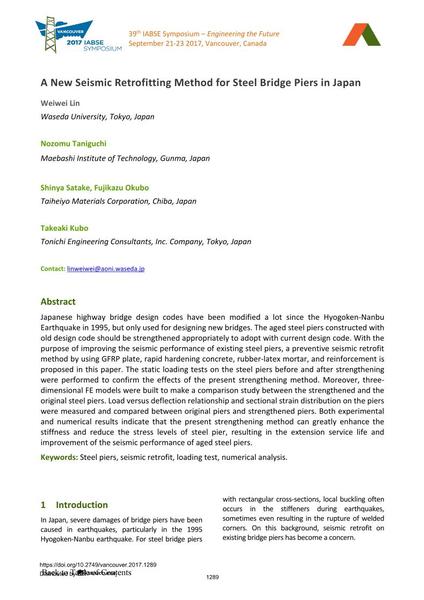A New Seismic Retrofitting Method for Steel Bridge Piers in Japan

|
|
|||||||||||
Bibliografische Angaben
| Autor(en): |
Weiwei Lin
(Waseda University, Tokyo, Japan)
Nozomu Taniguchi (Maebashi Institute of Technology, Gunma, Japan) Shinya Satake (Taiheiyo Materials Corporation, Chiba, Japan) Fujikazu Okubo (Taiheiyo Materials Corporation, Chiba, Japan) Takeaki Kubo (Taiheiyo Materials Corporation, Chiba, Japan) |
||||
|---|---|---|---|---|---|
| Medium: | Tagungsbeitrag | ||||
| Sprache(n): | Englisch | ||||
| Tagung: | IABSE Symposium: Engineering the Future, Vancouver, Canada, 21-23 September 2017 | ||||
| Veröffentlicht in: | IABSE Symposium Vancouver 2017 | ||||
|
|||||
| Seite(n): | 1289-1296 | ||||
| Anzahl der Seiten (im PDF): | 8 | ||||
| Jahr: | 2017 | ||||
| DOI: | 10.2749/vancouver.2017.1289 | ||||
| Abstrakt: |
Japanese highway bridge design codes have been modified a lot since the Hyogoken-Nanbu Earthquake in 1995, but only used for designing new bridges. The aged steel piers constructed with old design code should be strengthened appropriately to adopt with current design code. With the purpose of improving the seismic performance of existing steel piers, a preventive seismic retrofit method by using GFRP plate, rapid hardening concrete, rubber-latex mortar, and reinforcement is proposed in this paper. The static loading tests on the steel piers before and after strengthening were performed to confirm the effects of the present strengthening method. Moreover, three- dimensional FE models were built to make a comparison study between the strengthened and the original steel piers. Load versus deflection relationship and sectional strain distribution on the piers were measured and compared between original piers and strengthened piers. Both experimental and numerical results indicate that the present strengthening method can greatly enhance the stiffness and reduce the stress levels of steel pier, resulting in the extension service life and improvement of the seismic performance of aged steel piers. |
||||
| Stichwörter: |
numerische Analyse Erdbebennachbemessung
|
||||
